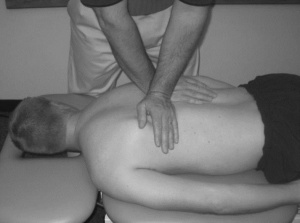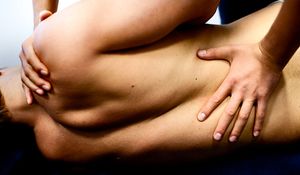Thoracic Manipulation for Shoulder Dysfunction: Difference between revisions
Maram Salem (talk | contribs) No edit summary |
Maram Salem (talk | contribs) (introduction, second section with how it is formatted and worded. I also added more links within the text and additional/recent research) |
||
| Line 11: | Line 11: | ||
== Introduction == | == Introduction == | ||
[[File: | [[File:Shoulder pain.jpg|thumb]] | ||
Shoulder pain is a common musculoskeletal disorder encountered in primary care.<ref>Tekavec E, Jöud A, Rittner R, Mikoczy Z, Nordander C, Petersson IF, Englund M. Population-based consultation patterns in patients with shoulder pain diagnoses. BMC musculoskeletal disorders. 2012 Dec;13(1):1-8.</ref> For the treatment of shoulder pain, physiotherapy is recommended as an initial form of conservative treatment.<ref>Littlewood C, Malliaras P, Chance-Larsen K. Therapeutic exercise for rotator cuff tendinopathy: a systematic review of contextual factors and prescription parameters. International Journal of Rehabilitation Research. 2015 Jun 1;38(2):95-106.</ref> Of the various interventions provided, thoracic [[Spinal Manipulation|manipulation]] (movement of high speed and low amplitude) may be applied. The latest research demonstrates that thoracic spinal manipulation yields a decrease in shoulder pain and overall improvements in function of the shoulder.<ref>Haik MN, Alburquerque-Sendín F, Silva CZ, Siqueira-Junior AL, Ribeiro IL, Camargo PR. Scapular kinematics pre–and post–thoracic thrust manipulation in individuals with and without shoulder impingement symptoms: a randomized controlled study. Journal of orthopaedic & sports physical therapy. 2014 Jul;44(7):475-87.</ref> | |||
== | == Factors to Consider == | ||
Below is a recommended list of factors to consider during an initial evaluation: | |||
1.Thoracic spine | '''Range of Motion ([https://physio-pedia.com/Range_of_Motion ROM]):''' | ||
Generally, patients with shoulder pain present with decreased active range of motion, yielding a decrease in functional mobility and capability.<ref>MacDermid JC, Ramos J, Drosdowech D, Faber K, Patterson S. The impact of rotator cuff pathology on isometric and isokinetic strength, function, and quality of life. Journal of Shoulder and Elbow Surgery. 2004 Nov 1;13(6):593-8.</ref>Maintaining shoulder ROM is an important factor for maintaining good functional capacity and improving a patient's level of independence. | |||
*Another explanation for use of TSTM with shoulder patients is the relationship of restoring mobility between adjacent vertebrae which may be blocked by entrapment of a meniscoid. | |||
*The relationship between reduced mobility of the cervicothoracic spine and shoulder pain could be explained by this reflexogenic mechanism. | '''Thoracic spine:''' | ||
*Abnormal biomechanical relationship between adjacent vertebra can also compress nerve roots, which can affect associated segmental muscular function, such as muscle spasms. This can cause abnormal movement patterns in the shoulder complex , including the scapulohumeral joint. | |||
*Use of manipulative treatment can help our patients not only improve their shoulder mobility, but improve their overall functional performance. | The shoulder, or [[Glenohumeral Joint|glenohumeral joint]], is affected by neighboring joints. It articulates with the rib cage via the scapula and is connected to the thoracic spine through various muscles. The thoracic spine forms a key link in the kinematic sequence of arm elevation. The position of the thoracic spine significantly affects scapular kinematics during scapular plane abduction. A slouched posture is associated with decreased shoulder range of motion and muscle force.<ref>Functional Anatomy of the Shoulder [Internet]. Physiopedia. Available from: <nowiki>https://www.physio-pedia.com/Functional_Anatomy_of_the_Shoulder</nowiki></ref> | ||
Thoracic side bending and rotation are caused my unilateral humeral motions. Thoracic rotation and glenohumeral external rotation indicate significant coupling of these segmental movements. <ref>Crosbie J, Kilbreathe SL, Hooman L, York S. Scapulohumeral rhythm and associated spinal motion. Clin Biomechan. 2008; 23: 184-192.</ref> | |||
*Another explanation for use of TSTM with shoulder patients is the relationship of restoring mobility between adjacent vertebrae which may be blocked by entrapment of a meniscoid. | |||
*The relationship between reduced mobility of the cervicothoracic spine and shoulder pain could be explained by this reflexogenic mechanism. | |||
*Abnormal biomechanical relationship between adjacent vertebra can also compress nerve roots, which can affect associated segmental muscular function, such as muscle spasms. This can cause abnormal movement patterns in the shoulder complex , including the scapulohumeral joint. | |||
*Use of manipulative treatment can help our patients not only improve their shoulder mobility, but improve their overall functional performance. | |||
[[File:Chris-benson-yx-iJFybOBQ-unsplash.jpg|right|frameless]] | [[File:Chris-benson-yx-iJFybOBQ-unsplash.jpg|right|frameless]] | ||
'''2.[[Posture|Postural]] dysfunctions''' | '''2.[[Posture|Postural]] dysfunctions''' | ||
Revision as of 23:56, 11 January 2024
Original Editor - Carla Benton
Top Contributors - Kim Jackson, Maram Salem, Admin, Dana Tew, Lucinda hampton, WikiSysop and Carla Benton - Your name will be added here if you are a lead editor on this page.
Introduction[edit | edit source]
Shoulder pain is a common musculoskeletal disorder encountered in primary care.[1] For the treatment of shoulder pain, physiotherapy is recommended as an initial form of conservative treatment.[2] Of the various interventions provided, thoracic manipulation (movement of high speed and low amplitude) may be applied. The latest research demonstrates that thoracic spinal manipulation yields a decrease in shoulder pain and overall improvements in function of the shoulder.[3]
Factors to Consider[edit | edit source]
Below is a recommended list of factors to consider during an initial evaluation:
Range of Motion (ROM):
Generally, patients with shoulder pain present with decreased active range of motion, yielding a decrease in functional mobility and capability.[4]Maintaining shoulder ROM is an important factor for maintaining good functional capacity and improving a patient's level of independence.
Thoracic spine:
The shoulder, or glenohumeral joint, is affected by neighboring joints. It articulates with the rib cage via the scapula and is connected to the thoracic spine through various muscles. The thoracic spine forms a key link in the kinematic sequence of arm elevation. The position of the thoracic spine significantly affects scapular kinematics during scapular plane abduction. A slouched posture is associated with decreased shoulder range of motion and muscle force.[5]
Thoracic side bending and rotation are caused my unilateral humeral motions. Thoracic rotation and glenohumeral external rotation indicate significant coupling of these segmental movements. [6]
- Another explanation for use of TSTM with shoulder patients is the relationship of restoring mobility between adjacent vertebrae which may be blocked by entrapment of a meniscoid.
- The relationship between reduced mobility of the cervicothoracic spine and shoulder pain could be explained by this reflexogenic mechanism.
- Abnormal biomechanical relationship between adjacent vertebra can also compress nerve roots, which can affect associated segmental muscular function, such as muscle spasms. This can cause abnormal movement patterns in the shoulder complex , including the scapulohumeral joint.
- Use of manipulative treatment can help our patients not only improve their shoulder mobility, but improve their overall functional performance.
2.Postural dysfunctions
The upper crossed postural syndrome (see also Forward Head Posture) ie the presence of 1.weak deep neck flexors coupled with weak rhomboids and lower trapezius (LT) and 2.Tight pecs coupled with tight upper traps. The position of the scapula on the thoracic wall affects posture, which could affect shoulder function.
3.Regional Interdependance- The clinical rationale for the use of thoracic manipulation with shoulder patients is based on regional interdependence, ie one area directly affects another. If one area, such as the thoracic spine is dysfunctional, it may affect the mobility of the shoulder as well, and create shoulder pain and limitations in function of the upper extremity. [7]
Neurophysiologic[edit | edit source]
Increased scapular strength with manipulation- Improved LT strength following thoracic spine mobilization and thrust manipulation.
Spinal level pain modulation-
- Immediate short-term reduction in numeric pain rating score (NPRS) and shoulder pain and disability index (SPADI) following cervico-thoracic spine manipulation.
- Postural correction in the thoracic spine decreases shoulder pain, and assists with increasing overall shoulder mobility.
- The effects of shoulder, cervical, and thoracic spine high velocity, low-amplitude (HVLA) chiropractic manipulative therapy in the treatment of frozen shoulder showed clinically meaningful changes in reduced pain and disability.
- There may be a relationship between symptoms of the upper extremity CRPS and the thoracic spine.
- Thoracic joint manipulation improved spinal mobility, and also assisted in decreasing distal and autonomic symptoms. This helped to improve overall functional performance of this patient’s upper extremity.
Conclusion[edit | edit source]
One can distinguish from the evidence that our approach to treatment of the shoulder patient should include thoracic manipulation.
- Many physical therapists are not comfortable with manipulation; however, as one can see, it is becoming mandatory to gain these manual skills to deliver successful treatment for our patients.
- Attending continuing education courses, as well as completing residencies, such as Evidence in Motion, can help us stay up with the evidence, and continue to grow our profession as manual experts.
- The challenge is on for all of us, young and old, to become recognized as experts in the treatment of musculoskeletal dysfunctions. We cannot do this without continuing to learn and grow, and using the evidence to help guide our interventions.
Intervention [edit | edit source]
Manual Techniques for the Cervicothoracic Spine
Case Studies[edit | edit source]
The effectiveness of thoracic manipulations on shoulder pain: A Case Report
Resources[edit | edit source]
- Rainbow DM, Weston JP, Brantingham JW, Globe G, Lee F. A prospective clinical trial comparing chiropractic manipulation and exercise therapy vs. chiropractic mobilization and exercise therapy for treatment of patients suffering from adhesive capsulitis/frozen shoulder. Journal of the American Chiropractic Association 2008; September/October: 12-28.
- Menck JY, Requejo SM, Kulig K. Thoracic spine dysfunction in upper extremity complex regional pain syndrome Type I. Journal of Orthopaedic and Sports Physical Therapy 2000; 30:401-409.
References[edit | edit source]
- ↑ Tekavec E, Jöud A, Rittner R, Mikoczy Z, Nordander C, Petersson IF, Englund M. Population-based consultation patterns in patients with shoulder pain diagnoses. BMC musculoskeletal disorders. 2012 Dec;13(1):1-8.
- ↑ Littlewood C, Malliaras P, Chance-Larsen K. Therapeutic exercise for rotator cuff tendinopathy: a systematic review of contextual factors and prescription parameters. International Journal of Rehabilitation Research. 2015 Jun 1;38(2):95-106.
- ↑ Haik MN, Alburquerque-Sendín F, Silva CZ, Siqueira-Junior AL, Ribeiro IL, Camargo PR. Scapular kinematics pre–and post–thoracic thrust manipulation in individuals with and without shoulder impingement symptoms: a randomized controlled study. Journal of orthopaedic & sports physical therapy. 2014 Jul;44(7):475-87.
- ↑ MacDermid JC, Ramos J, Drosdowech D, Faber K, Patterson S. The impact of rotator cuff pathology on isometric and isokinetic strength, function, and quality of life. Journal of Shoulder and Elbow Surgery. 2004 Nov 1;13(6):593-8.
- ↑ Functional Anatomy of the Shoulder [Internet]. Physiopedia. Available from: https://www.physio-pedia.com/Functional_Anatomy_of_the_Shoulder
- ↑ Crosbie J, Kilbreathe SL, Hooman L, York S. Scapulohumeral rhythm and associated spinal motion. Clin Biomechan. 2008; 23: 184-192.
- ↑ Wainner RS, Whitman JM, Cleland JA, Flynn TW. Regional Interdependence: A Musculoskeletal Examination Model Whose Time Has Come. J Ortho Sports Phys Ther. 2007; 37(11): 658-660.










